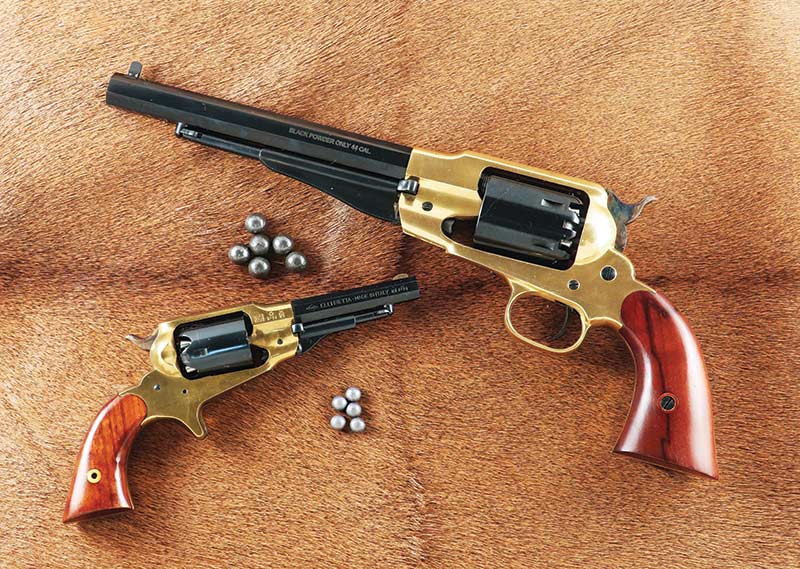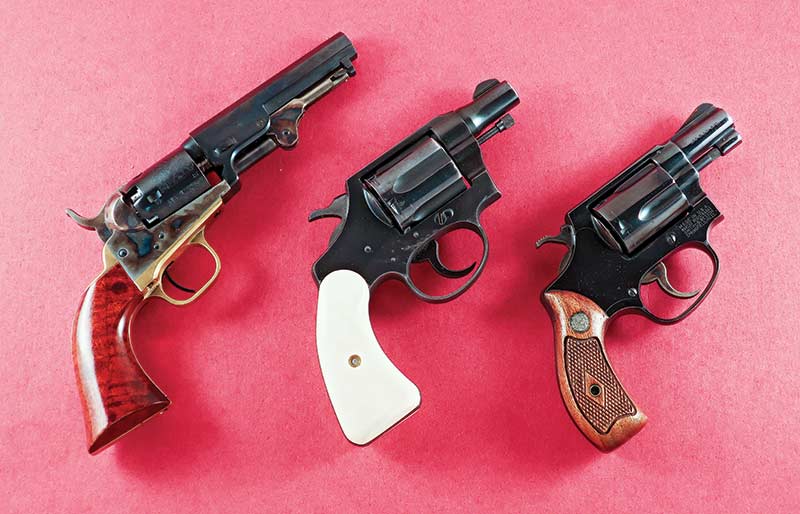Percussion Pocket
Pistols Of The 1850s
Before The J-Frames
“B” Western movies always show everyone being openly armed. This is fantasy and rarely happened, especially in towns. Carrying of weapons was forbidden by many municipalities but this did not prevent carry, it just changed it from openly carrying a large revolver to a hidden pocket pistol.
Samuel Colt began things by offering the first successful revolver, the Paterson in 1836. It was a great step forward from single-shot pistols and well accepted. However, Sam wound up bankrupt. The next step occurred when Sam Walker and Sam Colt got together to come up with something much better for combat than the fragile, folding-trigger Paterson. The result was the Walker of 1847, and then the Walker Whitneyville Dragoon, a transitional model which led to the 1st, 2nd and 3rd Model Dragoons.
Big Iron
The Paterson was produced in .28, .31, .34 and .40, all of which Sam Walker felt were underpowered. The Dragoons were definitely not and all of these were large, heavy, six-shot .44 percussion pistols weighing 4 lbs. or more and not easily carried. Colt’s first Belt Pistol, so-called as it was easily carried in a holster such as the “Slim Jim” on the belt, was the .36 caliber 1851 Navy followed by the .44 1860 Army and .36 1861 Navy. All three of these were extremely popular and easily and comfortably carried.
For a look at the history of the Colt Pocket Pistols I use as my resource, A History Of The Colt Revolver From 1836 To 1940 by Charles Haven and Frank Belden, 1940. This book is remarkable in its coverage of so many aspects of the history of Colt and personally remarkable as I purchased it in the Kent State University bookstore in 1963. What are the chances of finding any such book in a university bookstore today?
The following is from the Haven & Belden book: “The first pocket model put out by Colt in his new establishment on Pearl Street was a .31 caliber five-shot revolving pistol with a standard barrel length of 4″. The notches for the engagement of the cylinder-locking bolt were round or elliptical, the back of the trigger guard was square, there was no roller on the hammer at its bearing point on the mainspring and the arm had no ramrod. The barrel was octagonal and similar in shape to those of the small Paterson models, but the frame was square at the back like the ’48 Dragoon and all following models.”
The authors go on to refer to this as the Old Model Pocket Pistol that was later followed by the Old Model Police Pistol. Also according to the authors, the former is sometimes called the Baby Dragoon while the latter is identified as the Wells Fargo Colt.
There is considerable confusion and disagreement on the calling of this later model the Wells Fargo Colt. The authors say this: “As the Wells Fargo Express Company was not organized until 1851, and did not send its first representative to the West until 1852, three years after the improvements were applied to the Model of 1848 revolvers, one of two things must have been the case if the Model of 1848 with the arm supplied to them. Either Colt had on hand the stock of left-over arms of the earlier model, an unlikely occurrence when his factory could not keep up with his regular orders, or else a lot of old-type arms were specially made up for some reason that seemed good at the time. Either of these eventualities is, of course, possible but we consider them unlikely.”
Whatever the real situation, it is now lost to history but both models are available in replica form as the Model 1848 Baby Dragoon and the Model 1849 Wells Fargo. Both are of .31 caliber, five-shot and do not have loading levers/rammers. The cylinders must be loaded off the gun.
With all of these designs being offered, none of them, at least according to civilian sales, were the most popular. This distinction goes to the 1849 Pocket Pistol. This was a five-shot, .31 caliber single-action percussion pistol design for easy concealed carry. The fact it was the most popular of all percussion revolvers offered by Colt once again attests to the fact most sixguns of the time period were not carried openly but rather in a pocket.
Pocket Rocket
Belden & Haven say this about the most popular pistol: “The Improved Pocket Pistol was brought out by Colt in 1849. This arm differed from the model of 1848 in the following respects. In the regular issue, the trigger guard was rounded at the back, a loading lever, similar to the loading lever of the Dragoon and Navy Models, was attached, pins were placed between the nipples, and the hammer was slotted to rest on these pins as a safety stop while the arm was being carried, a wheel was put on the base of the hammer to ease the bearing of the mainspring, and the cylinder notches were changed to a rectangular shape with an inclined plane leading into them to guide the cylinder bolt, in case, owing to wear on the hand or ratchet, the cylinder did not index properly. The hammer and barrel-lug were also of slightly different shape…. Hundreds of thousands of these pistols were made between 1849 and 1872, and they were by far the most popular pocket revolvers in the world from the time they were first manufactured to the general adoption of cartridge revolvers in the early 1870s.”
It is easy to see from the authors’ description this Pocket Pistol Model 1849 had every possible upgrade to make it state-of-the-art at the time. It is still available to shooters in replica form and use thereof will soon show why it was such a popular offering in its time.
After the development of the 1849 Pocket Model, Colt switched back to producing Belt Pistols with the 1851 Navy .36 and the 1860 Army .44, the latter being the main sidearm of the Union forces in the Civil War. Sam then combined the .36 caliber chambering of the 1851 Navy with the streamlined look of the 1860 Army and the result was the 1861 Navy Model. Sam Colt must have seen the need for a more powerful pocket pistol as his last design was the 1862 Police Pistol, which was a scaled-down .36 Navy with a smaller grip, frame and a smaller five-shot cylinder. As the name implies, these were popular for police carry (again Belden & Haven): “The New Model Pocket Pistol of Navy Caliber was made on the same frame and grips as the Model of 1849 Pocket Pistol, but the forward part of the frame was cut away to make room for a round, rebated cylinder that was 1/32 of an inch larger in diameter at the front, and the tapering part of the barrel forward of the cylinder was cut back to allow for the length of the cylinder, which was 3/8 of an inch greater than in the Model of 1849. This cylinder contains five chambers of .36 caliber, taking the heavy conical bullet of the Navy Pistol, but with a slightly reduced powder charge. The barrel was identical in outside dimensions with the Model of 1849, and made in the usual octagonal form.… This model was made in barrel lengths of 4-1/2″, 5-1/2″ and 6-1/2″.”
Modern Updates
The Model 1862 is available today in replica form in all three barrel lengths mentioned. Realistically speaking, the .31 Pocket Pistol Models basically offer .22 Long Rifle power so it is easy to see why Colt decided to come out with a .36 Pocket Pistol, about equal to the power offered by a .38 Long Colt. To make my 1862 .36 Pocket Model even easier to carry, I had the standard barrel cut back to 2-1/2″ and fitted with an 1858 Remington front sight in a dovetail. This allowed me to easily adjust for windage and elevation. Both parts are available from VTI Gun Parts as are virtually all other parts for Italian-made replica revolvers.
All of my pocket pistols, as with all other cap and ball revolvers, have also been upgraded and made more reliable by the addition of SliXshot stainless steel nipples from SliXprings. These nipples are properly shaped to accept Remington #10 and CCI #11 caps and also vented to help prevent cap jams. Cap jams seem even more prevalent on the pocket pistols than on the belt pistols so these aftermarket nipples are a much-needed addition.
Remington also offered an extensive lineup of pocket pistols including double-action versions, however, thus far the only one offered in replica form is a five-shot, spur-trigger .31. Offered in both steel frame and brass frame versions, it is even smaller than the Colt Pocket Pistols and very easy to carry concealed. Perhaps someday other Remington Pocket Models will be offered. Perhaps.

Get More Revolver Content Every Week!
Sign up for the Wheelgun Wednesday newsletter here:













